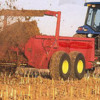In an ancient physics class, I recall one of my professors was discussing centrifugal forces that occur when objects are in rotation around an axis. He said that reason Metra trains run forward in one direction and backward in the other was to reduce the Coriolis effects on track. Generally, the Coriolis effect causes moving objects on the surface of the rotating Earth to be deflected in a clockwise sense (with respect to the direction of travel) in the Northern Hemisphere and in a counter-clockwise sense in the Southern Hemisphere.
So what that means is that an engine traveling North to South would tend to wear the wheels and track on one side and when traveling in the reverse direction from South to North the wear occurs on the other side. Einstein wrote about the asymmetric shaping of troughs in streams and rivers running in one direction that lay in a North-South orientation.
However, I dont think the engine situation is true. I think a better answer is that Metra has no way to turn engines around in Chicago or at the outlying end-points.
This sound like one of those silly questions. Like which weighs more? a bag containing 1000 lbs of feathers or a bag containing 1000 lbs of iron? ANSWER ; the bag containing the feathers as it would be much larger than the other bag.










